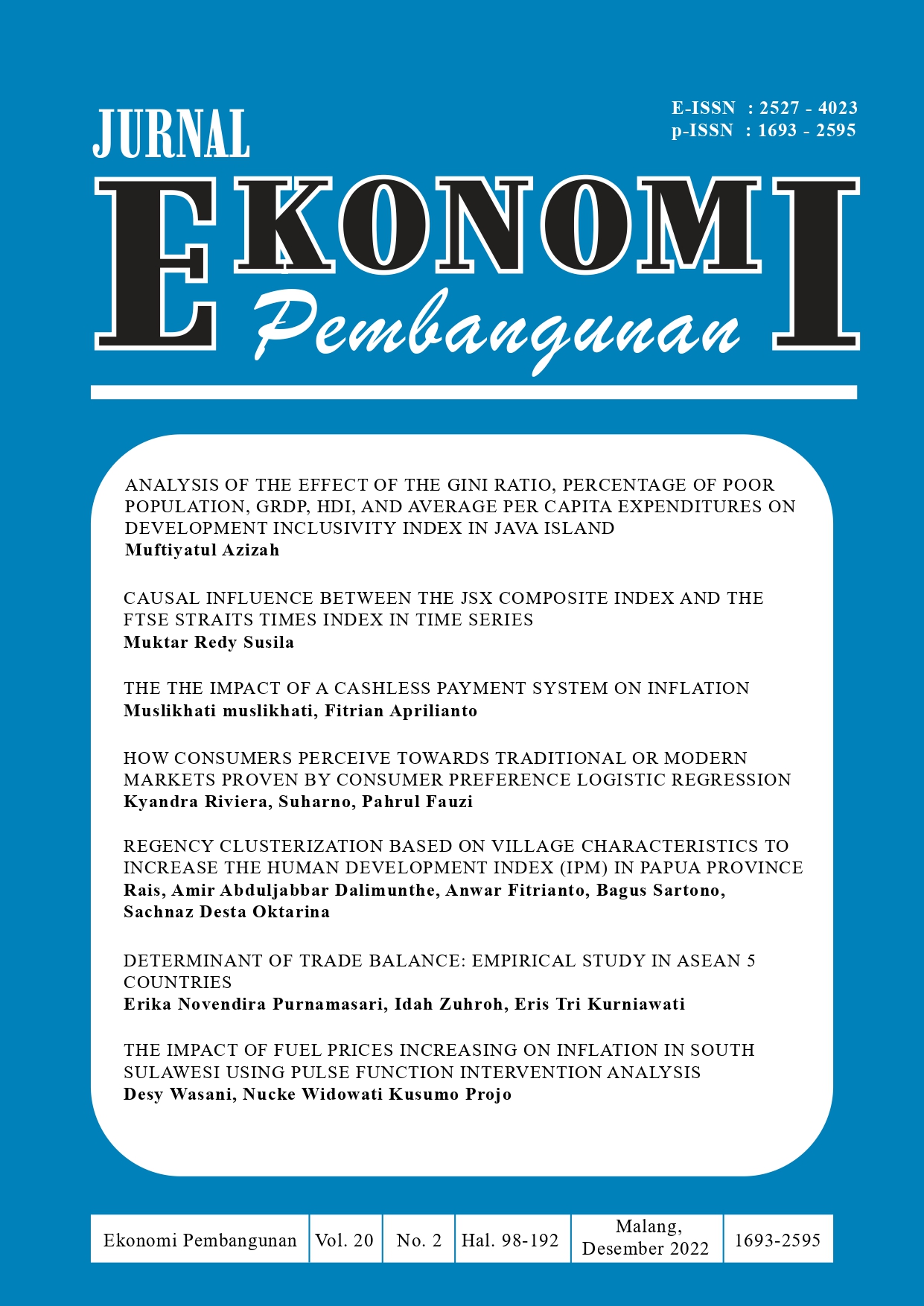The The Impact of a Cashless Payment System on Inflation
DOI:
https://doi.org/10.22219/jep.v21i02.20885Keywords:
Credit Card, Debit Card, E-Money, Inflation, Interest RateAbstract
The rise of transactions without using money or what is commonly referred to as cashless transactions. Cashless transactions have several advantages, namely, functional, effortless, and quick. In addition, cashless transactions get an impact on monetary policy in Indonesia. The convenience obtained when conducting cashless transactions results in the acceleration of the velocity of money. Although the number of cash transactions in the community has decreased, the rate of money creates a high intensity with the use of cashless transactions. If the power of money circulation is high, it is feared that it will cause inflationary effects. This study aims to determine the impact of the cashless payment system on inflation. A quantitative approach was used in this study with secondary data which in the source obtained through documentation techniques obtained from Bank Indonesia (BI) and the Central Statistics Agency (BPS). from January 2009 until December 2020. The analysis technique uses multiple linear regression analysis. The results showed that the electronic-money variables had a significant negative effect, the debit card variables had a significant positive impact, the credit card variables had an insignificant negative effect, and the interest rate variables had a significant positive impact.
Downloads
References
Andrieu, M. (2001). The future of e-money: Main trends and driving forces. Foresight, 3(5), 429–451. https://doi.org/10.1108/14636680110416779
Anggraini, D. T. (2016). Analisa Jumlah Uang Beredar Di Indonesia Tahun 2005-2014. Jurnal Moneter, 13(May), 31–48.
Fatmawati, M. N., & Yuliana, I. (2019). Pengaruh Transaksi Non Tunai Terhadap Jumlah Uang Beredar Di Indonesia Tahun 2015- 2018 Dengan Inflasi Sebagai Variabel Moderasi. Ekspansi: Jurnal Ekonomi, Keuangan, Perbankan Dan Akuntansi, 11(2), 269–283. https://doi.org/10.35313/ekspansi.v11i2.1608
Fujiki, H., & Tanaka, M. (2014). Currency demand, new technology, and the adoption of electronic money: Micro evidence from Japan. Economics Letters, 125(1), 5–8. https://doi.org/10.1016/j.econlet.2014.07.032
Fung, B. S. C., Huynh, K. P., & Sabetti, L. (2014). The impact of retail payment innovations on cash usage. The Journal of Financial Market Infrastructures, 3(1), 3–31. https://doi.org/10.21314/jfmi.2014.034
Geanakoplos, J., & Dubey, P. (2010). Credit cards and inflation. Games and Economic Behavior, 70(2), 325–353. https://doi.org/10.1016/j.geb.2010.02.004
Gujarati, D. N., & Porter, D. C. (2013). Basic Econometrics: Fifth Edition. In McGraw-Hill Irwin (Fifth). Douglas Reiner.
Istanto S, L., & Fauzie, S. (2014). Analisis Dampak Pembayaran Non Tunai Terhadap Jumlah Uang Beredar Di Indonesia. Jurnal Ekonomi Dan Keuangan, 2(10), 14817.
Juhro, S. M., & Iyke, B. N. (2019). Monetary policy and financial conditions in indonesia. Buletin Ekonomi Moneter Dan Perbankan, 21(3), 283–302. https://doi.org/10.21098/BEMP.V21I3.1005
Miskhin, F. S. (2016). The Economics Of Money, Banking, and Financial Markets (Eleventh). Pearson Education Limited.
Nainggolan, I. M., & Garnia, E. (2020). The Effect Of Volume And Nominal Of E-Money Transaction Of Inflation In Indonesia. Procuratio: Jurnal Ilmiah Manajemen, 8(2), 491–502. https://doi.org/https://doi.org/10.35145/procuratio.v9i2.960
Natsir, Muhammad. (2014). Ekonomi Moneter & Kebanksentralan. Jakarta: Mitra Wacana Media
Perlambang, H. (2017). Analisis Pengaruh Jumlah Uang Beredar, Suku Bunga Sbi, Nilai Tukar Terhadap Tingkat Inflasi. Media Ekonomi, 18(2), 49. https://doi.org/10.25105/me.v18i2.2251
Wahyuningsih, D., & Sasongko, G. (2021). Kausalitas E-Money Dan Inflasi Di Indonesia Periode 2009-2019. 23(2).
Downloads
Published
Issue
Section
License
Copyright (c) 2022 muslikhati muslikhati, Fitrian Aprilianto

This work is licensed under a Creative Commons Attribution-NonCommercial-ShareAlike 4.0 International License.
Authors who publish with Jurnal Ekonomi Pembangunan (JEP) agree to the following terms:
- For all articles published in Jurnal Ekonomi Pembangunan (JEP), copyright is retained by the authors. Authors permit the publisher to announce the work with conditions. When the manuscript is accepted for publication, the authors agree to the publishing right's automatic transfer to the publisher.
- Authors retain copyright and grant the journal right of first publication with the work simultaneously licensed under a Creative Commons Attribution-NonCommercial-ShareAlike 4.0 International License that allows others to share the work with an acknowledgment of the work's authorship and initial publication in this journal.
- Authors can enter into separate, additional contractual arrangements for the non-exclusive distribution of the journal's published version of the work (e.g., post it to an institutional repository or publish it in a book), with an acknowledgment of its initial publication in this journal.
- Authors are permitted and encouraged to post their work online (e.g., in institutional repositories or on their website) before and during the submission process, as it can lead to productive exchanges and earlier and greater citation of published work (See The Effect of Open Access).

This work is licensed under a Creative Commons Attribution-NonCommercial-ShareAlike 4.0 International License.






















